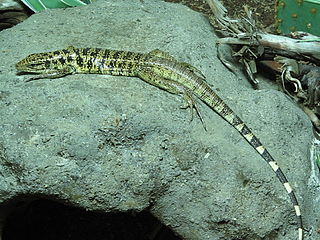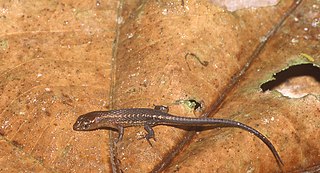Pseudogonatodes is a genus of geckos, often known as South American clawed geckos, containing seven described species.

Uracentron is a genus of Tropidurid lizards found in forests in northern South America. It contains only two species, which are both arboreal, have a relatively short spiny tail, and mainly feed on ants.

Crocodilurus is a lizard genus that belongs to the family Teiidae. It is monotypic, with only a single described species Crocodilurus amazonicus, the crocodile tegu. It is locally known as the Jacarerana. This semiaquatic lizard has a flattened, paddle-like tail and is found in the Amazon Basin and Guiana Shield in South America. It feeds on arthropods, amphibians, reptiles and fish.

Tupinambis is a lizard genus which belongs to the family Teiidae and contains eight described species. These large lizards are commonly referred to as tegus. T. merianae, T. rufescens, and T. teguixin are popular in the pet trade. They are primarily found in South America, although T. teguixin also occurs in Panama.

Cercosaura is a genus of lizards in the family Gymnophthalmidae. The genus is endemic to South America.

Echinosaura is a genus of lizards, called commonly the spined tegus, in the family Gymnophthalmidae. The genus is endemic to Central America and South America.

The Argentine black and white tegu, also called commonly the Argentine giant tegu, the black and white tegu, the huge tegu, and in Spanish as the lagarto overo is a species of lizard in the family Teiidae. The species is the largest of the "tegu lizards". It is an omnivorous species which inhabits the tropical rain forests, savannas, and semi-deserts of eastern and central South America.

Stenocercus is a genus of South American lizards, commonly called whorltail iguanas, of the family Tropiduridae. This genus has 68 valid described species.

Amphisbaena is a genus in the family Amphisbaenidae, commonly known as the worm lizards. Over 100 species are placed in this diverse genus.

Potamites is a genus of lizards in the family Gymnophthalmidae. The genus is restricted to northern South America and southern Central America. They are semi-aquatic and found near streams.
The South American gecko is a species of lizard in the family Sphaerodactylidae. The species is endemic to Brazil.
Cercosaura bassleri, known commonly as the ocellated tegu, is a species of lizard in the family Gymnophthalmidae. The species is endemic to Peru.
Loxopholis ferreirai is a species of lizard in the family Gymnophthalmidae. The species is endemic to Brazil.
Loxopholis osvaldoi is a species of lizard in the family Gymnophthalmidae. The species is endemic to Brazil.
Loxopholis percarinatum, Müller's tegu, is a species of lizard in the family Gymnophthalmidae. It is found in Guyana, Suriname, French Guiana, Venezuela, Colombia, Brazil, and Bolivia.

Loxopholis rugiceps is a species of lizard in the family Gymnophthalmidae. It is found in Colombia and Panama.
Loxopholis snethlageae is a species of lizard in the family Gymnophthalmidae. The species is endemic to Brazil.

Loxopholis southi, also known commonly as the northern spectacled lizard and the southern leposoma, is a species of lizard in the family Gymnophthalmidae. The species is native to southeastern Central America and northwestern South America. There are two recognized subspecies.

Alopoglossus angulatus, known commonly as the northern teiid, is a species of lizard in the family Alopoglossidae. The species is endemic to northern South America.












